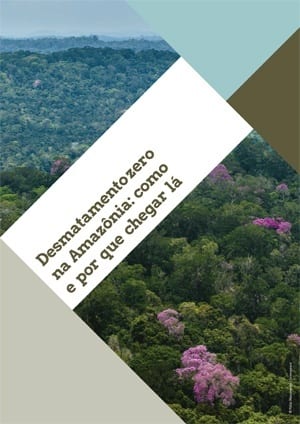

Greenpeace, Imaflora, Imazon, Instituto Centro de Vida, Instituto Socioambiental, IPAM, The Nature Conservancy e WWF. Desmatamento zero na Amazônia: como e por que chegar lá. Brasil, 2017.
Há várias maneiras de responder por que o Brasil precisa atingir o desmatamento zero (DZ) urgentemente. A resposta mais simples é: porque esta é a coisa certa a fazer. Não há mais justificativas para a destruição da vegetação nativa do país. Continuar a devastação resulta em desequilíbrio do clima global e nacional, afeta a biodiversidade e os recursos hídricos, além de comprometer a saúde e o bem-estar da população. Além disso, desmatar não ajuda a competitividade da agropecuária; ao contrário, coloca-a em risco. Extinguir de vez o desmatamento ilegal e legal é, por fim, um imperativo ético – uma dívida que a atual geração tem consigo própria e com as próximas.
A Amazônia brasileira tem sido, paradoxalmente, o ícone do controle e do descontrole do desmatamento tropical. É lá que estão as experiências que demonstram que a destruição ambiental pode ser vencida, mas é também lá que essa destruição segue em velocidade assustadora e explode a qualquer distração, vitimando a sociedade amazônica, o país e o mundo.
Este documento pretende indicar os possíveis caminhos para zerar o desmatamento na região, com benefícios ambientais, econômicos e sociais para o país. Preparado pelo Grupo de Trabalho pelo Desmatamento Zero – composto por especialistas das organizações Greenpeace Brasil, ICV, Imaflora, Imazon, IPAM, Instituto Socioambiental, WWF Brasil e TNC Brasil –, tem como lastro a mais atual literatura científica sobre florestas, clima e agropecuária. Nas seções que se seguem, são expostas as principais razões pelas quais o DZ é, mais do que possível, uma necessidade inadiável.
__________________________________________________
Greenpeace, Imaflora, Imazon, Instituto Centro de Vida, Instituto Socioambiental, IPAM, The Nature Conservancy and WWF. A Pathway to Zero Deforestation in the Brazilian Amazon. Brazil, 2017.
The Brazilian Amazon has been, paradoxically, the icon of control and lack of control of tropical deforestation. It is there that there are experiences that demonstrate that environmental destruction can be overcome, but it is also there that this destruction continues at a frightening speed and explodes under any distraction, victimizing the people of the Amazon, the country and the world.
The document indicates the possible ways to end deforestation in the region, with environmental, economic and social benefits for the country. Prepared by the Zero Deforestation Working Group – composed of experts from the organizations Greenpeace Brazil, ICV, Imaflora, Imazon, IPAM, Instituto Socioambiental, WWF Brazil and TNC Brazil -, it has the most current scientific literature on forests, climate and agriculture. In the following sections, the main reasons why ZD is, more than possible, an inescapable need.
This post was published on 13 de novembro de 2017
Título Índice de Progresso Social Brasil 2025 Autores Melissa Wilm Daniel Santos Beto Veríssimo Marcelo…
Amorim, L., Ferreira, R., Dias, M., Souza Jr., C., & Veríssimo, A. Sistema de Alerta…
Título Relatório Anual do Desmatamento no Brasil - RAD2024 Autores Carolina Del Lama Julia Shimbo…
Título Fatos da Amazônia 2025 Autores Daniel Santos Manuele Lima Agatha Vilhena Beto Veríssimo Caíque…
Amorim, L., Ferreira, R., Dias, M., Souza Jr., C., & Veríssimo, A. Sistema de Alerta…
Título A Vocação da Restauração Florestal na Amazônia com Base na Vegetação Secundária Autores Jayne…